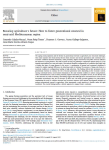Calafat-Marzal C., Roig-Tierno N., Cervera F.J., Gallego-Salguero A., García-Alvarez-Coque J.M. (2026). Ensuring agriculture's future: how to foster generational renewal in semi-arid Mediterranean region. Cities, 01/01/2026, vol. 168, p. 106422.
https://doi.org/10.1016/j.cities.2025.106422
https://doi.org/10.1016/j.cities.2025.106422
| Titre : | Ensuring agriculture's future: how to foster generational renewal in semi-arid Mediterranean region (2026) |
| Auteurs : | C. Calafat-Marzal ; N. Roig-Tierno ; F.J. Cervera ; A. Gallego-Salguero ; J.M. García-Alvarez-Coque |
| Type de document : | Article |
| Dans : | Cities (vol. 168, January 2026) |
| Article en page(s) : | p. 106422 |
| Langues : | Anglais |
| Langues du résumé : | Anglais |
| Catégories : |
Catégories principales 06 - AGRICULTURE. FORÊTS. PÊCHES ; 6.5 - Gestion des ExploitationsThésaurus IAMM INSTALLATION DES JEUNES ; TRANSMISSION D'EXPLOITATION ; ZONE SEMI ARIDE ; CLIMAT SEMI ARIDE ; REGION MEDITERRANEENNE |
| Résumé : | The ageing rural population and the decline in generational renewal in agriculture pose structural challenges. This study examines how farm-internal factors (farm structure and income generation) and contextual socioeconomic conditions (business dynamism, urban proximity, digital connectivity and public services) influence the attraction of young farmers. The study is based on fuzzy-set qualitative comparative analysis (fsQCA) of 542 Spanish municipalities in a semi-arid region. This analysis identifies configurations of conditions that jointly help or hinder the entry of young farmers to the sector. A combination of internal and contextual conditions is required to explain regional differences in attracting youths to farming. The presence of large-scale farms is a recurrent condition in configurations leading to high attraction. This finding reflects their prominent role in generational renewal. In contrast, the role of income generation varies depending on the economic context. Among contextual factors, local business dynamism is the only essential condition to attract young farmers. Other contextual factors, such as urban proximity, digital connectivity, and public services, do not directly lead to the attraction of youths to farming. This finding suggests that although these contextual factors create a more favourable environment, they are not decisive on their own. The study provides guidance for policymakers, emphasising the need to combine structural and economic measures with regional development strategies to promote generational renewal in agriculture. Most importantly, youth attraction is feasible under the right conditions. This crucial finding justifies a holistic approach to support farms' continuity. |
| Cote : | En ligne |
| URL / DOI : | https://doi.org/10.1016/j.cities.2025.106422 |







